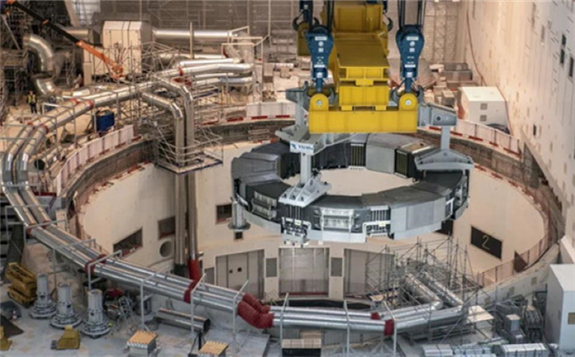
The PF6 coil was manufactured by the Institute of Plasma Physics of the Chinese Academy of Sciences (ASIPP), a member of the TAC1 consortium. Weighing 350 tonnes and an external diameter of about 11.2 meters, the PF6 coil is the heaviest of ITER's superconducting magnets. Composed of nine double-pancake-shaped coils and a series of supporting accessories, the PF6 coil winds up a niobium–titanium cable 13.5 kilometers in length. PF6 is the bottom-most of the six circular magnets surrounding ITER's vacuum chamber and the first one to be inserted in the tokamak pit.
Installation of the PF6 coil was completed by TAC1, a China-France consortium that is led by China National Nuclear Corporation subsidiary China Nuclear Power Engineering.
The operation to move the coil from the assembly hall and install it on its temporary support structures within the tokamak pit took about eight-and-a-half hours to complete. The operation had been rehearsed several times beforehand.
Production of the PF6 coil was completed at ASIPP in September 2019. Following final acceptance tests, the magnet was delivered in July 2020 to Fusion for Energy (F4E) - the Iter Organisation's European domestic agency - for cold tests and final checks at the Poloidal Fields coil factory built and run by Europe.
"It's a milestone of symbolic importance for the parties involved in this magnet because it paves the way for the assembly and insertion of the rest of the ITER coils," said Alessandro Bonito-Oliva, F4E magnets programme manager. "In this particular case, PF6 is very special because it is the outcome of an international collaboration between Europe and China based on trust, mutual learning and underpinned by team spirit."
ITER is a major international project to build a tokamak fusion device designed to prove the feasibility of fusion as a large-scale and carbon-free source of energy. The goal of ITER is to operate at 500 MW (for at least 400 seconds continuously) with 50 MW of plasma heating power input. It appears that an additional 300 MWe of electricity input may be required in operation. No electricity will be generated at ITER.
The European Union is contributing almost half of the cost of its construction, while the other six members (China, India, Japan, South Korea, Russia and the USA) are contributing equally to the rest.